Miracles Do Happen: The Story of My Comeback Kid!
When life presents you with a setback, it can feel like the end of the world. But what if I told you that any challenge that appears to come out of the blue is perfectly designed to escort you to whom you were always meant to be?
What if, in your darkest moments of despair, feeling alone and lost, you could have absolute faith that what you are going through will bring your potential to the surface?
This is my version of that story. It is a story of hope, resilience, trust, and faith. It is a story for anyone needing a glimmer of inspiration when they doubt if they can and will overcome. This is the story of my Comeback Kid, Riley, a three-sport high school athlete who faced a devastating and rare injury only to return to the field to win two state championships.
I'm sharing the story for two reasons. I hope the specifics will help people struggling through any knee or peroneal nerve injury see that recovery is possible. And more broadly, I'm sharing the story to help everyone, everywhere, see and believe that:
Miracles do happen.
The Phone Call
It was May 2020, and we were just in the beginning phase of the Covid-19 pandemic. Schools were closed, and community lockdowns were starting to be put into place. My sixteen-year-old son Riley was adjusting to no sports practices and to being at home for what looked to be a long summer. My daughter Hadley, who was ten at the time, was helping my husband and I pack up our camper for a weekend adventure into the wilderness.
I remember putting the remaining items into our car when my phone rang. It was Riley.
“Mom, I think I broke my leg.”
“What the fuck, Riley?”
(It wasn’t my best parenting response.)
“What happened? Where are you?” I asked.
“I’m at the park.” He said.
“I'll be right there,” I told him, as I raced to find my husband, Kristian.
My heart started to speed up as I spoke.
“Riley is hurt at the park. We have to go now.”
We jumped in my car and drove to our neighborhood park. When I got out, I saw Riley lying on the grass, surrounded by four football friends. One was freaking out, and the others looked utterly stunned. Riley was calm but in shock and obvious pain. His leg was already turning black, bruising from mid-thigh down to his ankle. His kneecap had just popped back into place from laterally dislocating, and he couldn’t straighten his leg. More concerning, he couldn't move his foot.
We asked Riley and the boys what happened. We learned that Riley and another boy were wrestling. Riley had picked up the boy, who was much heavier than he was, to throw him down. Suddenly, his foot got stuck, and all the weight of the boy’s body came crashing down on his right leg with an unforgettable force. His knee bowed out, and his kneecap immediately dislocated upon impact. That’s what we knew at the time.
We carried him into the car, drove back to our house, and got him into bed to assess the situation and collect ourselves. We knew we had to cancel our camping trip with our friends and made a phone call to tell them we couldn’t go. We also made a call to urgent care. Within the hour, we were in the waiting room.
What transpired from there was one hell of a journey. I get teary-eyed just recalling and writing about it.
The Diagnosis
We brought Riley to an orthopedic surgeon at Primary Children’s Hospital in Salt Lake City after getting a close friend, also an orthopedic surgeon, to make a personal call that helped us get on his schedule the next day.
He couldn’t believe what he saw. “Did someone tie Riley down and jump off a three-story building onto his leg? I’ve never seen trauma like this before.” Ugh. That wasn’t good! Neither were the results of the MRI.
It turned out that Riley’s right knee trauma was extensive. He had torn his ilia tibial (IT) band off the bone; severed his lateral collateral ligament (LCL), posterior collateral ligament (PCL), and anterior cruciate ligament (ACL); and tore his hamstring bicep muscle off the leg bone.
But that wasn’t the worst part. Unfortunately, with the medial-to-lateral impact forced so abruptly upon his knee, his peroneal nerve (the nerve that controls your ability to dorsiflex and control your foot motion) was injured. He suffered something called “Foot Drop” – also called Dropsy Foot – as a result of a peroneal nerve stretch injury. The stretch aspect made it nearly impossible to pinpoint where the actual location of nerve communication stopped.
Surgery and Recovery
On June 1, 2020, a month after the injury, Riley underwent reconstructive orthopedic surgery on the knee. His IT band, hamstring biceps, and LCL were repaired. His peroneal nerve was inspected, but it was left alone, along with his PCL and ACL. We were told to wait and see how Riley recovered. Hopefully, if we were lucky, his nerve would wake up over time.
Riley underwent a rigorous and intense rehabilitation plan to heal his knee. He was on crutches for six weeks and had to learn how to walk with a hard carbon fiber AFO, or ankle foot orthosis. He had to miss the fall football season, too – the first in ten years.
Rough and lonely days consumed Riley. It was painful to witness as a parent. We were worried. Would he ever be able to walk on his own again? Would he ever be able to return to football, lacrosse, and skiing, all the sports he loved? Through the worry, we stayed as positive as possible – staying open to miracles, believing in his resiliency, and praying for his nerve to wake up.
Every month we would drive down to the city for an EMG (electromyography), a diagnostic procedure used to assess the health of muscles and the nerve cells that control them.
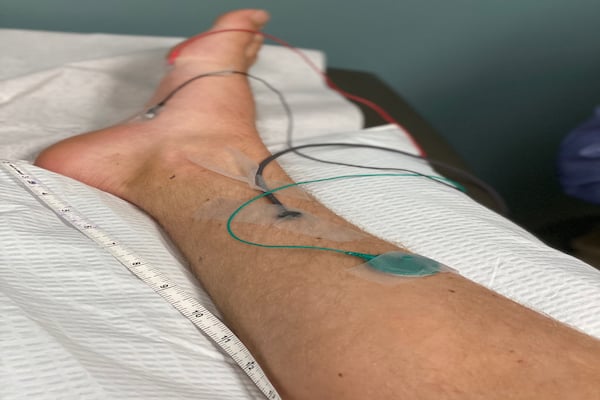
Every test, every time, showed nothing.
Finding Light In Dark Times
Our discouragement was compounded by a summer of social distancing, mask mandates, overflowing hospitals with COVID patients needing help, and further social isolation. Summer flowed into fall with the same constraints. Because he couldn't easily get around, Riley had to return to school online. He filled his moments with Fortnight, finding a new cohort of friends and a new outlet for his loss.
I never would have imagined being so grateful for a video game! But, thanks to Fortnight, Riley found and fostered connection through an online community. Playing filled his days and kept his mind off the wonder and worry that he would never be able to walk normally again.
But even so, he had some dark times, and it was gut-wrenching to watch my positive, outgoing, sweet boy sometimes want to give up. I could feel myself walking on eggshells, not wanting to do anything that would trigger the sadness, despair, and anger inside. I found myself scared for him and us while simultaneously holding the candle of hope and optimism. It was exhausting.
Seven months passed, and they weren’t easy. I relied on my training and background in holistic healing modalities and made Riley try acupuncture, PEMF, physical therapy, cold laser therapy, light therapy, and energy work. We also explored stem cell therapy. We continued getting EMG tests every month. Needles would be placed into his lower leg muscles, attached with electrodes to create and measure a stimulus-response. Each time, we’d cross our fingers and pray for some sign, only to be crushed with disappointment. After every visit, my impatience and impulse to do something would build.
The doctors told us that the nerve had a twenty-four-month window to return. We were told that if there were no signs of activity or nerve response, the shin muscles (the anterior tibialis and peroneus brevis) would turn to tissue. If this happened, there would not be any solution for regaining foot control.
I remember feeling like we were watching a ticking clock countdown backward two years to the day of his injury. As the days grew on, so did my restlessness. I remember suddenly feeling the urge to act. Something had to be done. There had to be a solution out there. I just knew it. And I knew we couldn’t wait any longer!
When Insight Lands
So, we began the research. We asked our amazing network of friends to help. I put out requests on social media and texted my closest confidants to help search for a nerve specialist who could help reverse foot drop. As life often does, it shows up when you need it most. Friends knew doctors at great hospitals and put us in touch. We followed up. We spoke with doctors who referred us to other doctors who referred us to others. We spoke with experts from John Hopkins University, New York Specialty Surgery, Stanford Medical, Massachusetts General, and the University of Utah.
We learned all about peroneal nerve injury and how rare it was. We learned that there weren’t any great options and were told verbatim, “There’s just no good solution. There’s no answer. You are swimming upstream."
One day, during Awesome Hour (a daily meeting my business partner, Jeff, and I have each morning to stay aligned in our co-leadership), I shared how discouraged I was at what I was learning. Jeff could hear the despair and sadness in my voice when suddenly, he thought of an organization that a colleague had just mentioned to him. He remembered it being an organization that could help members go to the top of the line for healthcare and connect with specialists they might need.
The Healthnetwork Foundation is a non-profit organization that connects CEOs and business leaders with top hospitals and doctors to provide fast access to world-class care. After a few minutes of investigating the organization’s site, the insight to act landed.
“I think this could help,” Jeff said.
“Yes, let’s do it,” I replied. A few minutes and a thousand dollars later, we were signed up as members.
The next day, I got a call from Michelle Williams, an account executive at the Health Network. She asked about my situation with Riley and listened. I told her what had happened and what we’d learned from talking to the top nerve specialists in the country. She could hear my conviction for a solution and was committed to helping. She asked me to email her what happened, what we had researched, whom we had talked to, and what we were looking for.
I had given this narrative many times and was already prepared with a detailed summary, anticipating all the questions I already knew the doctors would ask. I could see how all the dead-ends and fruitless attempts had prepared me to be direct, concise, and thorough.
Hope
A few days passed after I sent the email. I remember it clear as day. It was April 1st and Kristian and I were in the kitchen talking and cleaning up after dinner. It was around 9:00pm when my cell phone rang. On the other line was Dr. Glenn Pfeiffer, a nerve specialist from Cedars Sinai hospital. I put him on speaker and listened to him talk.
Dr. Pfeiffer had just received and read my email that the Healthnetwork had circulated. He wanted us to know that the doctor we were looking for had just arrived at Cedars Sinai. “His name is Dr. Mitchel Seruya, and I’ve already shared your email with him and discussed your case. If you are open to it, he will call you on your cell phone in thirty minutes,” Dr. Pfeiffer said. He spoke with such confidence, conviction – and a bit of mystery too.
“I don’t know how he does it," Dr. Pfeiffer continued, "but Dr. Seruya is pioneering some incredible new nerve transfers with success – he is a wizard in this field of medicine, and we are lucky to have him. I don’t know him well, but I’ve heard incredible things. I believe he’s your guy!”
At that moment, hope, optimism, and curiosity filled us both. We were mystified by what was unfolding. That feeling continued when the phone rang thirty minutes later from Dr. Seruya himself. We listened intently – we had become very educated ourselves from all the research and conversations with doctors we had previously had. As we listened to his recommendations and heard his answers to our specific questions, the tumblers began to fall into place, and we experienced “the landing” – the feeling when you know that you know. We felt excited, expanded, and clear. We felt hopeful. We felt optimistic. Everything Doctor Seruya shared made sense, and it felt like our best option with the highest probability of success.
Forty-five minutes passed, and before we hung up, we had surgery scheduled. Riley and I flew to Los Angeles three weeks later, and he underwent the pioneering nerve transfer. After almost seven hours in the operating room, Dr. Seruya had taken the nerve from Riley’s big toe and attached it to his upper shin muscles (anterior tibialis and the peroneus brevis). The intention was to rewire Riley’s lower leg and bypass the nerve damage altogether. If the surgery worked, Riley would think about curling his toes, and when he did, the nerve would be sent a signal to fire, resulting in his foot flexing. Not only would the physical re-attachment of the nerve need to work, but Riley himself would need to train his brain to create a new neuropathway. And that is exactly what he did.
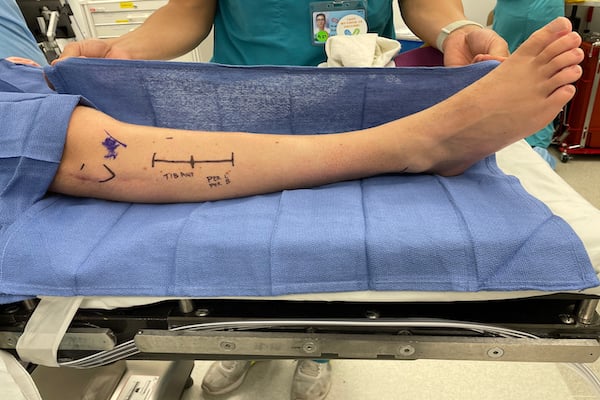
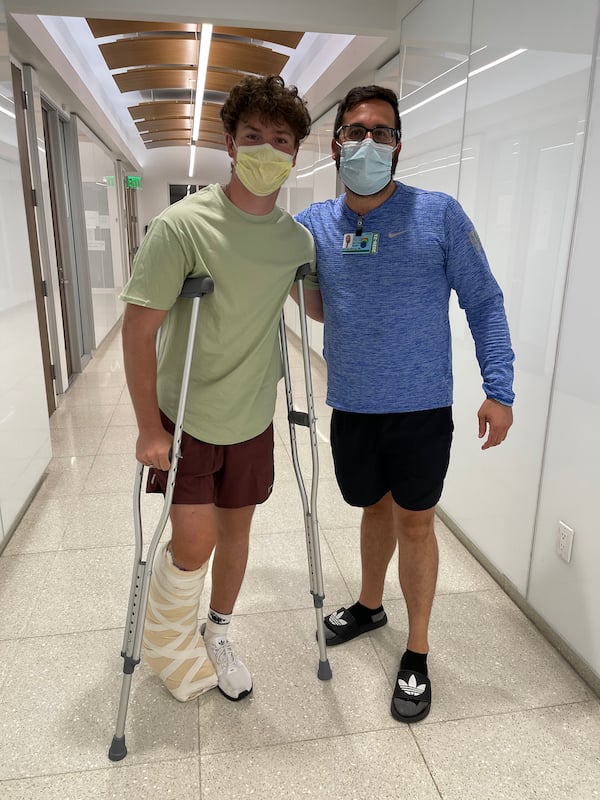
Rebuilding
The rehab was brutal – way harder than the knee. It was months of brain training, balance exercises, agility movements, kins stretching, muscle activation, and building with a phenomenal trainer named Ben Van Treese. Riley spent a ton of time getting his other body parts stronger based on the idea that we are a whole system, and if you get other parts to be strong, the weaker ones will follow.
Three months passed when one day all our family was sitting together in our living room. I grabbed Hadley’s feet and joked about how dirty her socks were. Riley’s feet happened to be resting on the side of the couch right in front of me, so I turned to him and said, “Riley, let’s see what you’ve got?” And I proceeded to take his socks off. “Can you flex your foot?”
Sure enough, he could! It was a miracle!
On his own and with a lot of focused brain power, he flexed his foot and got his ankle to cock. His toes even flexed too! I couldn’t believe my eyes. The surgery worked! Riley did it! Our comeback kid did it!
“Thank you, thank you, thank you,” I said aloud, directing gratitude to everyone present, my guides, our healing team, friends, family, and especially Dr. Seruya. I then had Riley repeat the movement and videotaped him doing it again so I could send it off to our doc so he could see his miracle work.
Miracles Do Happen
A few months later, Riley returned to the lacrosse field, wearing #17, the same jersey number that was retired when I played lacrosse in high school. With each game, he gained confidence in his body, strength in his mind, agility in his skill, and determination in his outlook. Throughout two seasons, he returned to win two State Championships and became one of the highest scorers on his team. He will graduate from Park City High School this week and head off to San Diego State University in the fall, where he will play lacrosse and study neuroscience, an area of interest birthed from his journey.
.jpeg?width=600&height=400&name=_F2I2492%20(1).jpeg)
.jpeg?width=600&height=400&name=182A0758%20(1).jpeg)
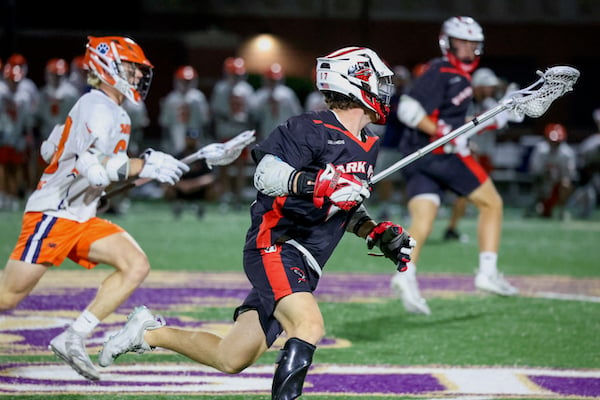
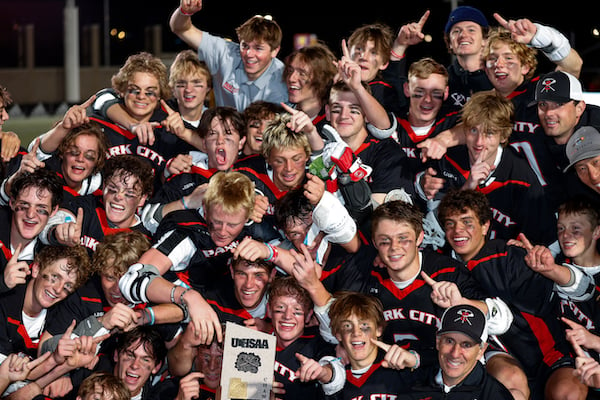
** Photos courtesy of Ben Crosby
I often reflect on what I learned as his mother. Riley modeled what’s possible when you put your heart and mind into whatever you desire. He showed me that we are born resilient. He taught me that we are meant to and will overcome no matter what deck we are handed in life. He allowed me to bring forth my faith in the Universe, noticing the signs of synchronicity and trusting the urge to know when to act. He showed me that he is so much more than an athlete – he is more than his gifts and talents. He is a model of determination, strength, hope, and resilience.
We all have this within us. We are designed this way. Regardless of your challenge, remember that you are wired to heal. You are meant to shine. You are destined to overcome and manifest miracles in the moment – they are just waiting for you to believe in their existence.
Keep walking one step at a time; soon enough, you will see that the comeback is always greater than the setback.
To learn how to recognize the signs in your life with greater awareness, create a deeper connection with your own insights, and trust you know when it’s time to act, come to Lantern, our leadership retreat for conscious leaders. Learn more here >>>
Share this
You May Also Like
These Related Stories

Practicing What You Preach: Surrendering to the Universe
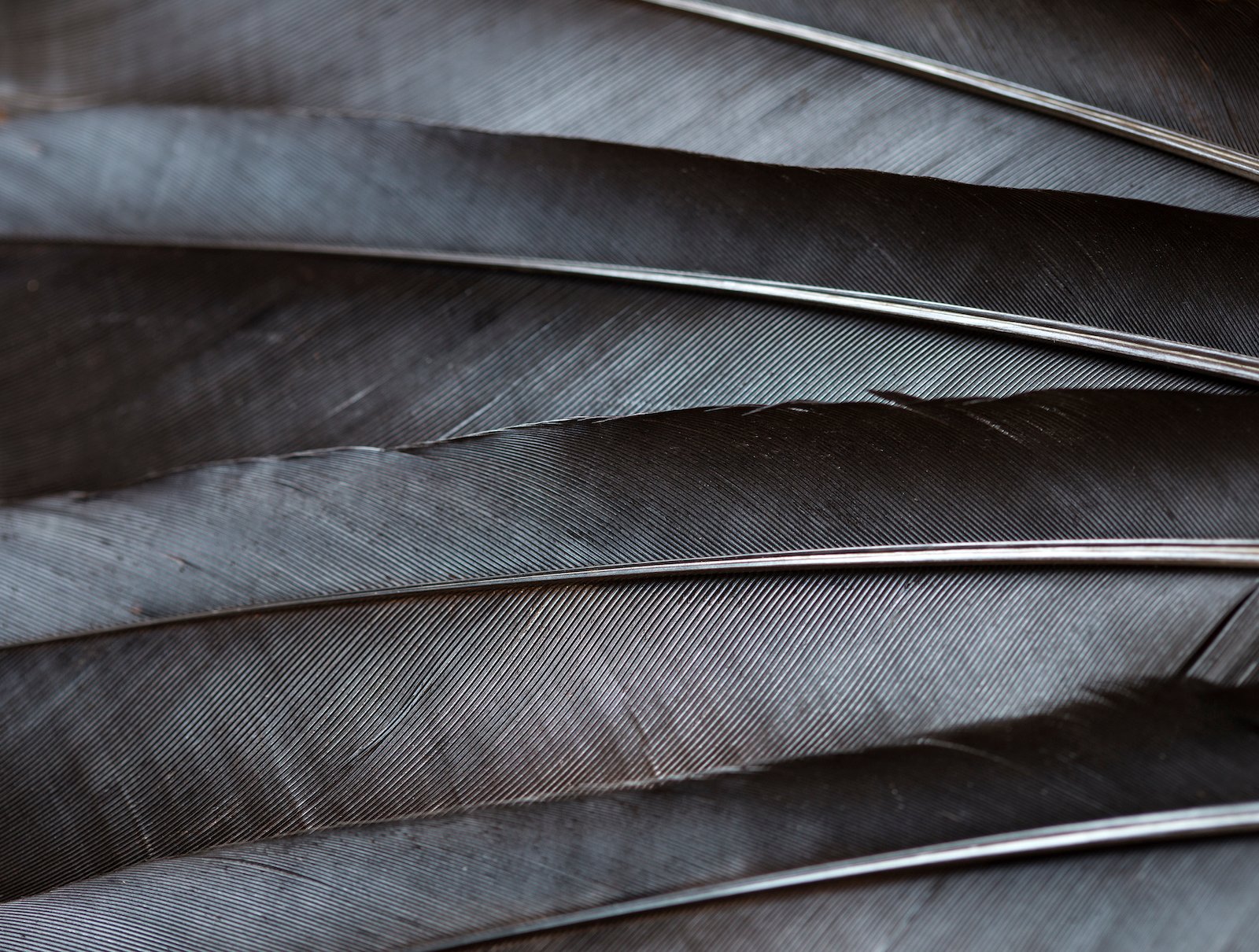
Learning in the Gray



Comments (3)